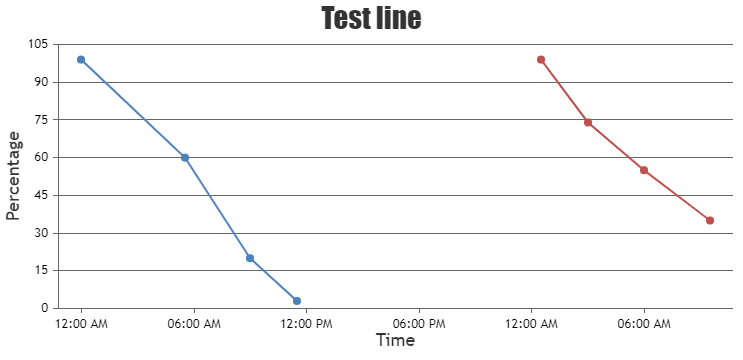Login to Ask a Question or Reply
Forum Replies Created by Vishwas R
-
You can use radius to make pie chart of fixed-size/radius irrespective of number of labels. Here is the updated jsfiddle.
As we checked your fiddle, you are using an older version of CanvasJS (v1.7.0). Kindly use the latest version of CanvasJS and stay updated with all the features and properties available.

Mats,
As of now, feature to set reserved width for the axisX label is not available. But you can set the maximum allowed width for labels using labelMaxWidth.
Sathya,
You can use valueFormatString to format date to show in 12Hours format. Check this example.
You can use Range Spline Area chart along with minimum to do so, check this example. And also you can change the code in our library (canvasjs.js), you can look into renderRangeSplineArea to modify Spline-Area chart.
Kindly use any of the following 4 date-formats.
1. ISO Dates (YYYY-MM-DD or YYYY-MM or YYYY-MM-DDTHH:MM:SS)
2. Long Dates (MMM DD YYYY)
3. Short Dates (MM/DD/YYYY or YYYY/MM/DD)
4. Full Format (full JavaScript format Ex: new Date(“Wed Mar 25 2015 09:56:24 GMT+0100 (W. Europe Standard Time)”);Please refer this page for Date-Formats in JavaScript.
Sorry this feature is not available, as of now.
Thanks for the jsfiddle. The behavior has been designed the way so that the marker won’t go out of plot-area and overlap other elements like labels, title etc.
We observed that you are setting minimum and maximum to exact value of minimum/maximum of dataPoint values, which clips the markers. You can overcome this by setting minimum and maximum of axisY in accordance with the dataPoint values. Check this jsfiddle.
Both formats works fine across browsers like Firefox, all chromium based except Internet Explorer as new Date(“Sun 02 03 2013 22:04:09”) is not a standard JavaScript DateTime format. Its suggested to use standard JavaScript DateTime formats to make it work properly across all browsers.
Budihar,
As of now its not possible to share common axis across multiple charts. But you can use two separate charts one below the other to achieve this as show in this example.
Budihar,
Yes it’s possible to combine candlestick chart with any other chart types except Doughnut, Pie, all Bar charts. Here is an example.
We observe that both formats are working fine.
{ x: new Date("Sun 02 03 2013 22:04:09"), y: 26}, { x: new Date("Sun Feb 03 2013 22:04:09"), y: 26}Here is the screenshot of the same.
Can you please create a jsfiddle with the issue, so that we can look into it and resolve.Teresa,
You can use dataPointWidth to increase/decrease the width of dataPoint (column in your case) which is nothing but reducing/increasing the gap between columns.
Sorry, as of now Bar chart Cannot be combined with any other chart types except Bar and Stacked Bar charts.
Sorry we don’t have this feature as of now. We had considered it, but found intervals were not proper. For example, if minimum is 0, maximum is 80 and user likes to have 7 ticks in that range, interval comes out to be 11.42857142857143 (~11.43), which is not convenient to the user. But we’ll reconsider this feature in future releases.
As of now, you can manually calculate interval to achieve the same. For Example, if the minimum is 0, maximum is 90 and if you like to show 8 number of ticks, you can set interval to 11.25.
